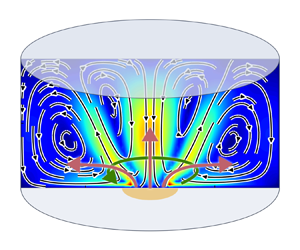Published online by Cambridge University Press: 28 September 2022

Liquid metal flows, generated in a cylindrical cell by a strong electric current flowing from the central bottom electrode to the sidewall, are studied experimentally and numerically. In the absence of an external magnetic field, the flow is caused by the interaction of the electric current with its own magnetic field and is known as electro-vortex flows (EVF), which has a pure poloidal configuration. It is also well known that even a relatively weak azimuthal force (which immediately arises if a vertical external magnetic field is applied) induces a swirl that completely changes the structure of the flow, suppressing the poloidal motion (Davidson et al., Eur. J. Mech. B Fluids, vol. 18, 1999, pp. 693–711). We study the steady-state modes and analyse the dynamics of transient modes, following the evolution of the flow structure at different ratios of azimuthal and poloidal Lorentz forces, governed by the applied current and vertical magnetic field. In the considered problem, the peculiarities of transient modes, leading to the suppression of the poloidal flow, are associated with the fact that the domain of acting forces is localized in the vicinity of the bottom electrode. The scenario of flow evolution strongly depends on the ratio of electro-vortex and rotational forces (whether the EVF has time to form before a noticeable swirl of the metal, or the swirl dominates from the beginning of flow evolution).